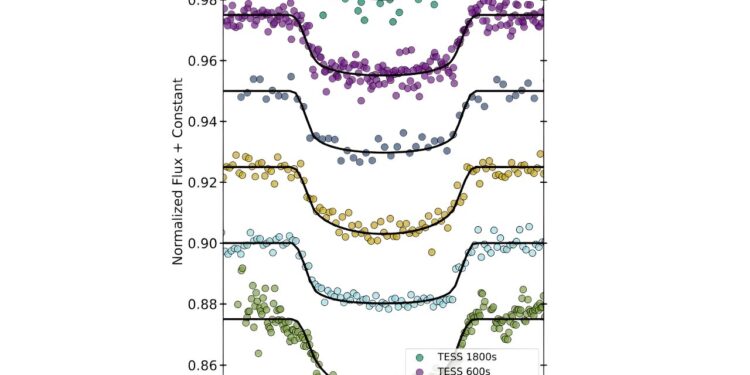TOI-2107: Unpooled TESS and ground tracking transits, phase-folded and presented relative to best-fit conjunction time with arbitrary normalized flow offset. Multiple TESS sectors in the same cadence are stacked on top of each other. Credit: arXiv (2024). DOI: 10.48550/arxiv.2401.05923
Using NASA’s Transiting Exoplanet Survey Satellite (TESS), an international team of astronomers has discovered nine new “hot Jupiter” exoplanets. One of the newly detected alien worlds is almost four times as massive as Jupiter. The discovery was presented in a paper published Jan. 11 on the preprint server. arXiv.
TESS is conducting a survey of about 200,000 of the brightest stars near the sun in an effort to search for transiting exoplanets, ranging from small rocky worlds to gas giants. So far, it has identified more than 7,000 candidate exoplanets (TESS Objects of Interest, or TOI), of which 415 have been confirmed.
Now, a group of astronomers led by Jack Schulte of Michigan State University has confirmed nine more planets monitored by TESS. They report that transit signals have been detected in the light curves of nine distant stars. The planetary nature of these signals was later confirmed by ground-based images and spectroscopic observations.
“In this paper, we present nine new hot Jupiters discovered by NASA’s TESS mission as part of an ongoing effort to discover and characterize all HJs (hot Jupiters) orbiting FGK stars brighter than G = 12.5 mag,” the researchers wrote.
The new exoplanets, designated TOI-1855 b, TOI-2107 b, TOI-2368 b, TOI-3321 b, TOI-3894 b, TOI-3919 b, TOI-4153 b, TOI-5232 b and TOI-5301 b. , are mostly similar in size to Jupiter, but their masses vary from 0.55 to 3.88 Jupiter masses. TOI-3919 b is the most massive, while the largest is TOI-1855 b, with a radius of approximately 1.65 Jupiter radii.
All of the newly discovered planets have orbital periods less than eight days and their equilibrium temperatures were estimated to be between 1,000 and 1,772 K. The hottest exoplanet among the nine was found to be TOI-5232 K.
The properties of these extrasolar worlds allowed the team to classify them as hot Jupiters. These planets have similar characteristics to Jupiter, while their orbital periods are less than 10 days. They have high surface temperatures because they orbit very close to their parent stars.
It was noted that TOI-3919 b and TOI-5301 b have significant orbital eccentricities, at a level of 0.26 and 0.33, respectively. According to the paper’s authors, this suggests that they may have undergone high-eccentricity tidal migration.
As for the host stars of the new exoplanets, they have radii ranging from 0.84 to 2.19 solar radii, while their masses are between 0.9 and 1.57 solar masses. The two oldest stars are estimated to be around 8 billion years old. The stars are located between 576 and 1,985 light years away.
Summarizing the results, the researchers stressed that the new findings could help us advance our knowledge of the formation and evolution of hot Jupiters.
More information:
Jack Schulte et al, Migration and Evolution of Giant Exoplanets (MEEP) I: nine newly confirmed hot Jupiters from the TESS mission, arXiv (2024). DOI: 10.48550/arxiv.2401.05923
Journal information:
arXiv
© 2024 Science X Network
Quote: TESS discovers nine new “hot Jupiters” (January 17, 2024) retrieved January 17, 2024 from
This document is subject to copyright. Except for fair use for private study or research purposes, no part may be reproduced without written permission. The content is provided for information only.



